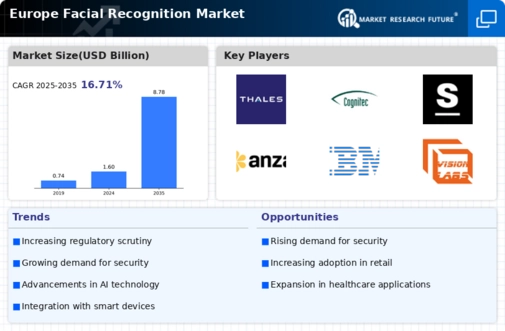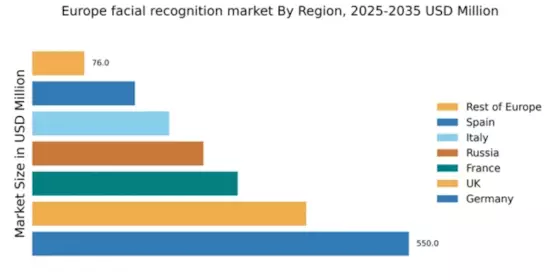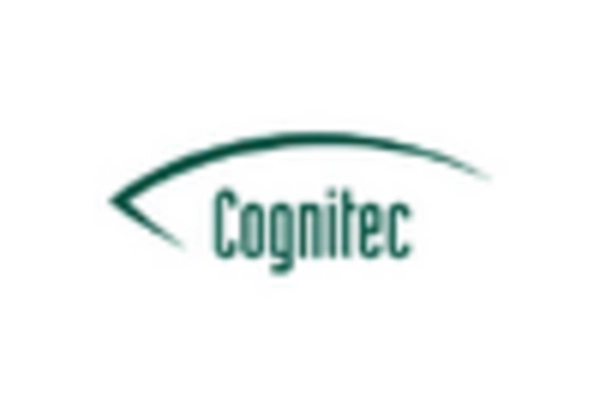Growing Investment in Smart City Initiatives
The push towards smart city initiatives across Europe is significantly impacting the facial recognition market. Cities are increasingly adopting advanced technologies to improve urban living, enhance public safety, and streamline services. Facial recognition systems are being integrated into various smart city applications, such as traffic management and public transportation. By 2025, the market is projected to grow to €3.2 billion, driven by substantial investments from municipal governments and private sector partnerships. This trend indicates a shift towards more interconnected urban environments, where facial recognition technology plays a crucial role in enhancing operational efficiency and citizen engagement.
Rising Demand for Enhanced Security Solutions
The increasing need for robust security measures across various sectors is driving the facial recognition market in Europe. Organizations are investing heavily in advanced technologies to mitigate risks associated with unauthorized access and criminal activities. In 2025, the market is projected to reach approximately €3 billion, reflecting a compound annual growth rate (CAGR) of around 15% from previous years. This surge is largely attributed to the growing concerns over public safety and the need for efficient surveillance systems. As a result, the facial recognition market is witnessing a significant uptick in demand from law enforcement agencies, airports, and public venues, all seeking to enhance their security protocols through innovative solutions.
Increased Focus on Customer Experience in Retail
The retail sector in Europe is increasingly leveraging facial recognition technology to enhance customer experience and optimize operations. By utilizing facial recognition systems, retailers can analyze customer behavior, personalize marketing strategies, and improve service delivery. This trend is expected to drive the facial recognition market, with projections indicating a market value of €1.5 billion by the end of 2025. As competition intensifies, retailers are likely to adopt innovative solutions that not only enhance customer satisfaction but also streamline inventory management and loss prevention efforts. Consequently, the integration of facial recognition technology is becoming a pivotal aspect of retail strategies across Europe.
Regulatory Frameworks Supporting Technology Adoption
The establishment of regulatory frameworks aimed at promoting the responsible use of facial recognition technology is influencing the market landscape in Europe. Governments are increasingly recognizing the potential benefits of facial recognition systems while also addressing privacy concerns. In 2025, it is anticipated that the facial recognition market will benefit from clearer guidelines that facilitate technology adoption while ensuring compliance with data protection laws. This regulatory support is expected to enhance public trust and encourage organizations to invest in facial recognition solutions. As a result, the market could see a growth trajectory that aligns with the evolving legal landscape, potentially reaching €2.8 billion by the end of the year.
Technological Advancements in Imaging and Processing
The rapid evolution of imaging technologies and processing capabilities is a key driver for the facial recognition market in Europe. Innovations in camera technology, such as high-resolution imaging and infrared capabilities, have improved the accuracy and reliability of facial recognition systems. Furthermore, advancements in processing power, particularly through the integration of edge computing, allow for real-time analysis and decision-making. This technological progress is expected to propel the market forward, with estimates suggesting a market value of €2.5 billion by the end of 2025. As organizations seek to leverage these advancements, the facial recognition market is likely to experience increased adoption across various applications, including retail, banking, and transportation.

















Leave a Comment